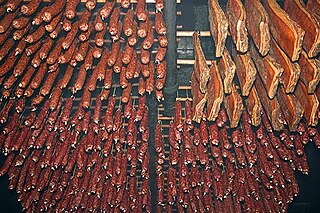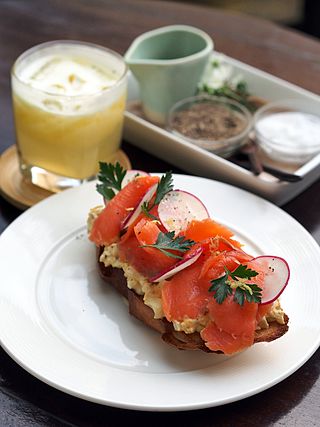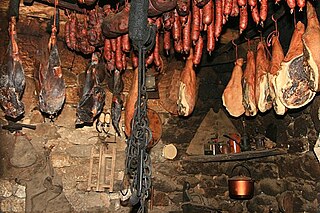Related Research Articles

A kipper is a whole herring, a small, oily fish, that has been split in a butterfly fashion from tail to head along the dorsal ridge, gutted, salted or pickled, and cold-smoked over smouldering wood chips.

Smoking is the process of flavoring, browning, cooking, or preserving food, particularly meat, fish and tea, by exposing it to smoke from burning or smoldering material, most often wood.

Smoked salmon is a preparation of salmon, typically a fillet that has been cured and hot or cold smoked.

Roe, or hard roe, is the fully ripe internal egg masses in the ovaries, or the released external egg masses, of fish and certain marine animals such as shrimp, scallop, sea urchins and squid. As a seafood, roe is used both as a cooked ingredient in many dishes, and as a raw ingredient for delicacies such as caviar.

A chipotle, or chilpotle, is a smoke-dried ripe jalapeño chili pepper used for seasoning. It is a chili used primarily in Mexican and Mexican-inspired cuisines, such as Tex-Mex and Southwestern United States dishes. It comes in different forms, such as chipotles en adobo.

Smoked meat is the result of a method of preparing red meat, white meat, and seafood which originated in the Paleolithic Era. Smoking adds flavor, improves the appearance of meat through the Maillard reaction, and when combined with curing it preserves the meat. When meat is cured then cold-smoked, the smoke adds phenols and other chemicals that have an antimicrobial effect on the meat. Hot smoking has less impact on preservation and is primarily used for taste and to slow-cook the meat. Interest in barbecue and smoking is on the rise worldwide.

The following outline is provided as an overview of and topical guide to the preparation of food:

Smoked fish is fish that has been cured by smoking. Foods have been smoked by humans throughout history. Originally this was done as a preservative. In more recent times fish is readily preserved by refrigeration and freezing and the smoking of fish is generally done for the unique taste and flavour imparted by the smoking process.

Fresh fish rapidly deteriorates unless some way can be found to preserve it. Drying is a method of food preservation that works by removing water from the food, which inhibits the growth of microorganisms. Open air drying using sun and wind has been practiced since ancient times to preserve food. Water is usually removed by evaporation but, in the case of freeze-drying, food is first frozen and then the water is removed by sublimation. Bacteria, yeasts and molds need the water in the food to grow, and drying effectively prevents them from surviving in the food.

The term fish processing refers to the processes associated with fish and fish products between the time fish are caught or harvested, and the time the final product is delivered to the customer. Although the term refers specifically to fish, in practice it is extended to cover any aquatic organisms harvested for commercial purposes, whether caught in wild fisheries or harvested from aquaculture or fish farming.

Cured fish is fish which has been cured by subjecting it to fermentation, pickling, smoking, or some combination of these before it is eaten. These food preservation processes can include adding salt, nitrates, nitrite or sugar, can involve smoking and flavoring the fish, and may include cooking it. The earliest form of curing fish was dehydration. Other methods, such as smoking fish or salt-curing also go back for thousands of years. The term "cure" is derived from the Latin curare, meaning to take care of. It was first recorded in reference to fish in 1743.

The food of the Tlingit people, an indigenous group of people from Alaska, British Columbia, and the Yukon, is a central part of Tlingit culture, and the land is an abundant provider. A saying amongst the Tlingit is that "When the tide goes out the table is set." This refers to the richness of intertidal life found on the beaches of Southeast Alaska, most of which can be harvested for food. Another saying is that "in Lingít Aaní you have to be an idiot to starve". Since food is so easy to gather from the beaches, a person who cannot feed himself at least enough to stay alive is considered a fool, perhaps mentally incompetent or suffering from very bad luck. Though eating off the beach could provide a fairly healthy and varied diet, eating nothing but "beach food" is considered contemptible among the Tlingit, and a sign of poverty. Shamans and their families were required to abstain from all food gathered from the beach, and men might avoid eating beach food before battles or strenuous activities in the belief that it would weaken them spiritually and perhaps physically as well. Thus for both spiritual reasons as well as to add some variety to the diet, the Tlingit harvest many other resources for food besides what they easily find outside their front doors. No other food resource receives as much emphasis as salmon; however, seal and game are both close seconds.

Bokkoms is whole, salted and dried mullet, and is a well-known delicacy from the West Coast region of South Africa. This salted fish is dried in the sun and wind and is eaten after peeling off the skin. In some cases it is also smoked. It is sometimes referred to as "fish biltong".

Fish preservation is the method of increasing the shelf life of fish and other fish products by applying the principles of different branches of science in order to keep the fish, after it has landed, in a condition wholesome and fit for human consumption. Ancient methods of preserving fish included drying, salting, pickling and smoking. All of these techniques are still used today but the more modern techniques of freezing and canning have taken on a large importance.

Traditional Grimsby smoked fish are regionally processed fish food products from the British fishing town of Grimsby, England. Grimsby has long been associated with the sea fishing industry, which once gave the town much of its wealth. At its peak in the 1950s, it was the largest and busiest fishing port in the world.

Ethmalosa fimbriata, the bonga shad or just bonga, is a shad-like ray-finned fish, belonging to the family Dorosomatidae, formerly considered to be in the family Clupeidae. This species occurs along the coasts and in brackish water of coastal lagoons, rivers and lakes of western Africa from Dakhla in Western Sahara to Lobito in Angola. It is usually around 25 cm long but the maximum length is 45 cm. It is the only member of its genus.

Sardines are a nutrient-rich, small, oily fish widely consumed by humans and as forage fish by larger fish species, seabirds and marine mammals. Sardines are a source of omega-3 fatty acids. Sardines are often served in cans, but can also be eaten grilled, pickled, or smoked when fresh.

Cod and other cod-like fish have been widely used as food through history. Other cod-like fish come from the same family (Gadidae) that cod belong to, such as haddock, pollock, and whiting.

Yup'ik cuisine refers to the Inuit and Yup'ik style traditional subsistence food and cuisine of the Yup'ik people from the western and southwestern Alaska. Also known as Cup'ik cuisine for the Chevak Cup'ik dialect speaking Eskimos of Chevak and Cup'ig cuisine for the Nunivak Cup'ig dialect speaking Eskimos of Nunivak Island. This cuisine is traditionally based on meat from fish, birds, sea and land mammals, and normally contains high levels of protein. Subsistence foods are generally considered by many to be nutritionally superior superfoods. Yup’ik diet is different from Alaskan Inupiat, Canadian Inuit, and Greenlandic diets. Fish as food are primary food for Yup'ik Eskimos. Both food and fish called neqa in Yup'ik. Food preparation techniques are fermentation and cooking, also uncooked raw. Cooking methods are baking, roasting, barbecuing, frying, smoking, boiling, and steaming. Food preservation methods are mostly drying and less often frozen. Dried fish is usually eaten with seal oil. The ulu or fan-shaped knife is used for cutting up fish, meat, food, and such.
References
- A practical guide to improved fish smoking in West Africa, Brownell B., UNICEF (1983)
- Utilization of Bonga (Ethmalosa fimbriata) in West Africa. A. Jallow, FAO (1994)
- Impact of adoption in Ghana of an improved fish processing technology on household income, health and nutrition”, Nti C., Plahar W., & Larweh P., International Journal of Consumer Studies 26 (2), 102-108 (2002)